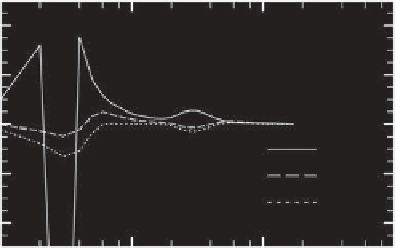Geoscience Reference
In-Depth Information
(a)
(b)
0.0080
0.0080
0.0040
0.0040
0.0000
0.0000
T
K
T
P
B
T
K
T
P
B
-0.0040
-0.0040
-0.0080
-0.0080
10
0
10
1
10
2
10
3
10
0
10
1
10
2
10
3
k
h
/
∆
k
k
h
/
∆
k
(c)
0.0080
0.0040
0.0000
T
K
T
P
B
-0.0040
-0.0080
10
0
10
1
10
2
10
3
k
h
/
∆
k
Figure 8.5.
Horizontal wave number spectra of kinetic and potential energy transfer and buoyancy flux in simulations with fixed
N
= 0.566 s
−1
and different
ν
(and hence different Re and Re
b
), corresponding to Re
b
= (a) 2.6, (b) 0.63, and (c) 0.16 (runs A6,
B4, and C2, as in Figure 8.2a). Spectra are multiplied by
k
h
to preserve area under the curves with loglinear axes.
terms are not shown but can be deduced as residuals since
the spectra are approximately stationary. For the largest
Re (Figure 8.5a), three distinct spectral ranges are appar-
ent. Small wave numbers are dominated by the forcing:
Kinetic energy is injected around
k
h
/k
is dissipated. As the Reynolds number (and hence Re
b
)
decreases, strong dissipation is felt over a wider range of
k
h
, and the small-scale peaks in transfer and buoyancy flux
are suppressed (Figures 8.5b and 8.5c). In the smallest Re
b
case, the energy injected by forcing is transferred only to
nearby wave numbers, where it is dissipated directly.
Figure 8.6 shows transfer and buoyancy flux spectra
from three simulations with approximately equal buoy-
ancy Reynolds numbers around 2. These spectra are con-
sistent with the picture described above: there is a short
forcing range, followed by a plateau of positive trans-
fer and negligible buoyancy flux, followed by large peaks
of positive
T
K
(k
h
)
and negative
T
P
(k
h
)
and
B(k
h
)
.As
Fr
h
decreases and Re increases, the plateau gets longer as
the peaks move downscale (in Figure 8.6a, the peaks are
adjacent to the forcing range and no plateau is obtained).
The position of the peak moves to larger
k
h
as Fr
h
decreases and Re increases, similar to the spectral bumps
in Figure 8.3a. The magnitude of the bump does not
diminish with decreasing Fr
h
, suggesting that even smaller
3, where it
is primarily removed by nonlinear interactions and sent
downscale (the rest is dissipated directly at
k
f
or converted
to potential energy). For
k
h
≈
k
f
, there is a range over
which
T
K
(k
h
)
and (to a lesser extent)
T
P
(k
h
)
are positive
and
B(k
h
)
0. If this range of
k
h
were a true inertial
subrange, the transfer would be zero. The positive transfer
implies that some of the kinetic energy injected into these
scales is dissipated, which is to be expected since Re
b
=2.6
is not very large.
Downscale of this plateau of positive transfer, there is a
major transition in the spectral energy balance. A large
peak in
T
K
(k
h
)
around
k
h
/k
≈
≈
40 points to a signif-
icant injection of kinetic energy. Some of this energy
is converted to potential energy via the negative peak
in buoyancy flux around the same scale, and the rest



















